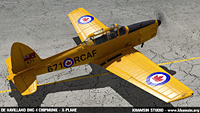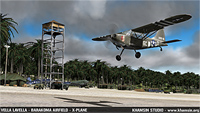INSTRUMENTS
RIGHT CONSOLE (FRONT COCKPIT)

- 1. AVIONICS MASTER SWITCH This switch toggles power supply for the whole navigation panel. It requires the primary bus to be supplied with electricity, AND the inverter to be ON. If the inverter is NOT on OR if it is out of order, the avionics will not function at all.
- 2. TRANSPONDEUR Pressing on each button will increase the corresponding figure by 1 increment, for instance, pressing the 2nd button will increase hundreds from X3XX to X4XX. The buttons work only in the incresing direction.
- 3. DUAL ADF-NDB Both ADF are "active". There is no "stand-by" mode. The needle gives absolute bearing to the nearest NDB corresponding to the selected frequency.
- 4. UHF RADIO CONTROL PANEL Com1 and Com2 are unnecessary to fly. Actually, whatever you set, you can contact ATC. As this might change in Xplane10, 2 operationnal Com radios are supplied.
- 5. NAVIGATION FREQS CONTROL PANEL Both Nav are "active". there is no stand-by mode. The Nav1 frequency controls both the RMI needle #1 and the ILS display. Each button increase either units or decimals. The special button "CARRIER" sets the carrier ils frequency in one-click, thus the RMI #1 points toward the nearest carrier, the ils sets itself to the glide pattern of the carrier.
- 6. AUTOPILOT
The autopilot is simple but robust. It allows the use of 4 modes :
- Attitude
- Leveled flight
- Speed with climb
- Heading
- 7. ELECTRICAL SWITCH PANEL On the switch panel, labels are quite self-explainatory. Simply note the "ext" button that allows the secondary bus (external supply) to be set ton "on", and the duo inverter/generator, which use is mandatory in flight.
- 8. PARK BRAKE HANDLE Probably you have an idea of its use :-) Anyway, please note that brakes are hydraulic.
- 9. IGNITION SWITCH Allows starting sequence to be efficient.
- 10. OXYGEN BLINKER This will blink more and more as the oxygen supply is used.
- 11. CIRCUIT BREAKER PANEL Inopperant.
"M" Stands for MASTER. If you press this button and this button only, the plane will try and hold her current attitude : pitch, roll, yaw.
"H" Stands for HEADING. The plane will turn to, then maintain, the direction that is set on the large compass on the autopilot console, represented by the double-needle. You can set the desired value with the button HDG+ and HDG-.
"S" Stands for SPEED. Actually it is "speed with climb", rather than "flight level change", as it works UPWARDS and not DOWNWARDS. If You engage this mode, 2 behaviours are possible : if the dialed flight level is ABOVE your current altitude, the plane will climb up to this FL, then level and accelerate. If the dialed flight level is BELOW your current altitude, the plane will immediately level and accelerate.
So, if you want to level your plane immediately, turn on S mode, then set a FL below you. If you want to go down, FIRST, set a FL below you, THEN engage S mode, THEN reduce thrust.
www.khamsin.org - © 2013



